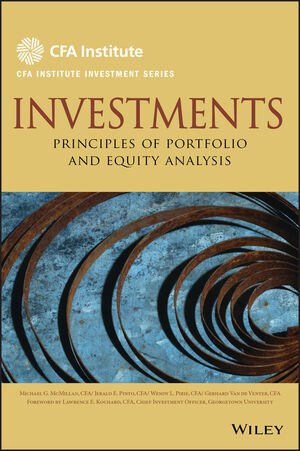|
Textbook
Investments: Principles of Portfolio and Equity AnalysisISBN: 978-0-470-91580-6
Hardcover
656 pages
February 2011, ©2011
 This is a Print-on-Demand title. It will be printed specifically to fill your order. Please allow an additional 10-15 days delivery time. The book is not returnable.
|
||||||
Acknowledgments xv
Introduction xvii
CHAPTER 1 Market Organization and Structure 1
Learning Outcomes 1
1. Introduction 1
2. The Functions of the Financial System 2
3. Assets and Contracts 10
4. Financial Intermediaries 24
5. Positions 35
6. Orders 41
7. Primary Security Markets 47
8. Secondary Security Market and Contract Market Structures 51
9. Well-Functioning Financial Systems 56
10. Market Regulation 58
11. Summary 61
CHAPTER 2 Security Market Indices 73
Learning Outcomes 73
1. Introduction 73
2. Index Definition and Calculations of Value and Returns 75
3. Index Construction and Management 78
4. Uses of Market Indices 90
5. Equity Indices 91
6. Fixed-Income Indices 94
7. Indices for Alternative Investments 96
8. Summary 101
CHAPTER 3 Market Efficiency 109
Learning Outcomes 109
1. Introduction 109
2. The Concept of Market Efficiency 111
3. Forms of Market Efficiency 118
4. Market Pricing Anomalies 124
5. Behavioral Finance 131
6. Summary 134
CHAPTER 4 Portfolio Management: An Overview 139
Learning Outcomes 139
1. Introduction 139
2. A Portfolio Perspective on Investing 140
3. Investment Clients 149
4. Steps in the Portfolio Management Process 156
5. Pooled Investments 160
6. Summary 172
CHAPTER 5 Portfolio Risk and Return: Part I 175
Learning Outcomes 175
1. Introduction 175
2. Investment Characteristics of Assets 176
3. Risk Aversion and Portfolio Selection 200
4. Portfolio Risk 209
5. Efficient Frontier and Investor’s Optimal Portfolio 222
6. Summary 234
CHAPTER 6 Portfolio Risk and Return: Part II 243
Learning Outcomes 243
1. Introduction 243
2. Capital Market Theory 244
3. Pricing of Risk and Computation of Expected Return 256
4. The Capital Asset Pricing Model 267
5. Beyond the Capital Asset Pricing Model 284
6. Summary 287
CHAPTER 7 Basics of Portfolio Planning and Construction 295
Learning Outcomes 295
1. Introduction 295
2. Portfolio Planning 296
3. Portfolio Construction 312
4. Summary 326
CHAPTER 8 Overview of Equity Securities 331
Learning Outcomes 331
1. Introduction 331
2. Equity Securities in Global Financial Markets 332
3. Types and Characteristics of Equity Securities 338
4. Private versus Public Equity Securities 345
5. Investing in Nondomestic Equity Securities 347
6. Risk and Return Characteristics of Equity Securities
353
7. Equity Securities and Company Value 356
8. Summary 362
CHAPTER 9 Introduction to Industry and Company Analysis 369
Learning Outcomes 369
1. Introduction 370
2. Uses of Industry Analysis 370
3. Approaches to Identifying Similar Companies 371
4. Industry Classification Systems 374
5. Describing and Analyzing an Industry 385
6. Company Analysis 412
7. Summary 417
CHAPTER 10 Equity Valuation: Concepts and Basic Tools 425
Learning Outcomes 425
1. Introduction 426
2. Estimated Value and Market Price 426
3. Major Categories of Equity Valuation Models 428
4. Present Value Models: The Dividend Discount Model 430
5. Multiplier Models 445
6. Asset-Based Valuation 457
7. Summary 461
CHAPTER 11 Equity Market Valuation 469
Learning Outcomes 469
1. Introduction 469
2. Estimating a Justified P/E Ratio 470
3. Top-Down and Bottom-Up Forecasting 484
4. Relative Value Models 491
5. Summary 506
CHAPTER 12 Technical Analysis 515
Learning Outcomes 515
1. Introduction 515
2. Technical Analysis: Definition and Scope 516
3. Technical Analysis Tools 520
4. Elliott Wave Theory 563
5. Intermarket Analysis 566
6. Summary 568
Problems 570
Glossary 575
References 589
About the Authors 595
About the CFA Program 601
Index 603



